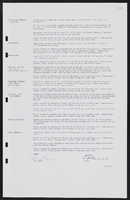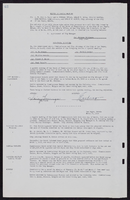Search the Special Collections and Archives Portal
Search Results
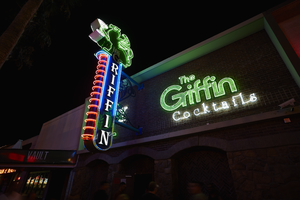
Photograph of The Griffin sign, Las Vegas (Nev.), June 28, 2017
Date
2017-06-28
2017-08-15
Archival Collection
Description
The sign for The Griffin sits at 511 Fremont Street in Downtown Las Vegas. Information about the sign is available in the Southern Nevada Neon Survey Data Sheet.
Site address: 511 Fremont St
Sign owner: Aaron Chepenik and Jonathan Hensleigh
Sign details: Opened in February of 2007 as a medieval British pub/ tavern style bar. This location brought on a wave of revitalization of the East Fremont District especially since many new bars/restaurants started to open in this area after this bar did.
Sign condition: 5- still looks relatively new
Sign form: Blade and overlay neon on building
Sign-specific description: Placed above the entrance their brick building the letters The Griffin Cocktails is painted with white block letters outlined with black paint is painted on the building itself. These letters have skeletal neon surrounding the letters. The Griffin letters are yellow tubes and do illuminate green at night, the word cocktails lights up white. To the left of the entrance but still on the building is a green painted griffin drinking a painted white martini ( also all outlined with black paint) The neon tubing outlining the griffin is a yellow tubing but glows green at night ( possibly argon inserted to make it glow green). The Blade is placed a little left of the entrance and hangs off of the building by two blue steel beams, but in between the beams is a beautiful swirl design. At the top of the Blade there is a green griffin sipping a martini (same design as the one painted on the building). At the base of the griffin is white THE letters painted with skeletal neon. Then below is the blue portion of the blade spelling out GRIFFIN in a Britannic looking font in white channeled letters which do illuminate white at night. This part of the blade is outlined in neon ,possibly argon, since it does illuminate blue at night. On the side of the blade ( if you're looking from the road) there are about 14 red curved neon tubes lining the sign.
Sign - type of display: Neon
Sign - media: Steel and Brick Wall
Sign - non-neon treatments: Using the brick wall as a portion of the sign is a design not seen often in Vegas.
Sign animation: Oscillation of red neon tubes on the side of the sign.
Sign environment: Located in the Fremont East District in between Las Vegas Blvd. and 6th St. This location has The Vault to the East of it and The Smashed Pig Gastropub to the west. It is across the street from the Park and Evil Pie. In the middle of the street right in front of the Griffin Bar is the Martini Glass sign.
Sign manufacturer: YESCO
Sign designer: Owners Aaron Chepenik and Jonathan Hensleigh-Aaron stated that the blade portion of the sign was inspired by the old Boulder Club Blade sign
Sign - date of installation: Slightly before they opened so late 2006/early 2007
Sign - thematic influences: Griffin shows that it has a medieval and kind of fantasy kind of feel since its interior does have that cool medieval tavern vibe to it, especially with their fireplaces. Using their brick wall as a part of the sign is a cool innovative way to use their space and stay true to their theme.
Sign - artistic significance: Medieval theme. The blade is a prominent theme in the 50s/60s, though their blade sign was inspired by the Boulder Club (opened 1931-1960) blade.
Survey - research locations: Acessors page, outreach to owner Aaron Chepenik
Survey - research notes: Possible use of argon within their yellow painted tubes, similar to the Yucca Motel signs leaves.
Survey - other remarks: The Blade does look very similar to the Boulder Club blade, so its awesome to see modern properties paying homage to the ones that are no longer around.
Surveyor: Emily Fellmer
Survey - date completed: 2017-09-15
Sign keywords: Oscillating; Steel; Neon; Blade; Fascia; Building-front design
Site address: 511 Fremont St
Sign owner: Aaron Chepenik and Jonathan Hensleigh
Sign details: Opened in February of 2007 as a medieval British pub/ tavern style bar. This location brought on a wave of revitalization of the East Fremont District especially since many new bars/restaurants started to open in this area after this bar did.
Sign condition: 5- still looks relatively new
Sign form: Blade and overlay neon on building
Sign-specific description: Placed above the entrance their brick building the letters The Griffin Cocktails is painted with white block letters outlined with black paint is painted on the building itself. These letters have skeletal neon surrounding the letters. The Griffin letters are yellow tubes and do illuminate green at night, the word cocktails lights up white. To the left of the entrance but still on the building is a green painted griffin drinking a painted white martini ( also all outlined with black paint) The neon tubing outlining the griffin is a yellow tubing but glows green at night ( possibly argon inserted to make it glow green). The Blade is placed a little left of the entrance and hangs off of the building by two blue steel beams, but in between the beams is a beautiful swirl design. At the top of the Blade there is a green griffin sipping a martini (same design as the one painted on the building). At the base of the griffin is white THE letters painted with skeletal neon. Then below is the blue portion of the blade spelling out GRIFFIN in a Britannic looking font in white channeled letters which do illuminate white at night. This part of the blade is outlined in neon ,possibly argon, since it does illuminate blue at night. On the side of the blade ( if you're looking from the road) there are about 14 red curved neon tubes lining the sign.
Sign - type of display: Neon
Sign - media: Steel and Brick Wall
Sign - non-neon treatments: Using the brick wall as a portion of the sign is a design not seen often in Vegas.
Sign animation: Oscillation of red neon tubes on the side of the sign.
Sign environment: Located in the Fremont East District in between Las Vegas Blvd. and 6th St. This location has The Vault to the East of it and The Smashed Pig Gastropub to the west. It is across the street from the Park and Evil Pie. In the middle of the street right in front of the Griffin Bar is the Martini Glass sign.
Sign manufacturer: YESCO
Sign designer: Owners Aaron Chepenik and Jonathan Hensleigh-Aaron stated that the blade portion of the sign was inspired by the old Boulder Club Blade sign
Sign - date of installation: Slightly before they opened so late 2006/early 2007
Sign - thematic influences: Griffin shows that it has a medieval and kind of fantasy kind of feel since its interior does have that cool medieval tavern vibe to it, especially with their fireplaces. Using their brick wall as a part of the sign is a cool innovative way to use their space and stay true to their theme.
Sign - artistic significance: Medieval theme. The blade is a prominent theme in the 50s/60s, though their blade sign was inspired by the Boulder Club (opened 1931-1960) blade.
Survey - research locations: Acessors page, outreach to owner Aaron Chepenik
Survey - research notes: Possible use of argon within their yellow painted tubes, similar to the Yucca Motel signs leaves.
Survey - other remarks: The Blade does look very similar to the Boulder Club blade, so its awesome to see modern properties paying homage to the ones that are no longer around.
Surveyor: Emily Fellmer
Survey - date completed: 2017-09-15
Sign keywords: Oscillating; Steel; Neon; Blade; Fascia; Building-front design
Mixed Content
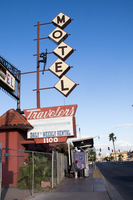
Photographs of Travelers Motel sign, Las Vegas (Nev.), 2017
Date
2017-04-18
2017-06-28
2017-08-18
Archival Collection
Description
The Travelers Motel sign sits at 1100 Fremont Street in Downtown Las Vegas. Information about the sign is available in the Southern Nevada Neon Survey Data Sheet.
Site address: 1100 Fremont St
Sign details: This location was constructed in 1926. Though the year of when the Traveler's Motel opened in unknown though its sign states, "Your Best Bet In Las Vegas Since 1936'. Though Vintage Las Vegas' blog states that the Traveler's Motel acquired some of their land from the Lucky Motel. Currently the Traveler's Motel is closed and gated up.
Sign condition: 3, the sign is fairly in condition. However, the sign does not light up at night. The sign that used to read "Traveler's Motel" that was affixed to the iron gate-like structure appears to have the majority of its sign taken down or destroyed in recent times.
Sign form: Blade Pole sign and Porte Cochere
Sign-specific description: This sign is attached to the building that belongs to and extends outward to Fremont Street. The lower portion of this sign has the same details on each side of the sign. The top portion of this sign is a trapezoid with "Traveler's" painted on it in a cursive text except for the "t." This is done in white on a rust colored background. Neon is also affixed to "Traveler's." Underneath this is a plastic back lit sign detail the various accommodations of the property, such as: phone, cable T.V., microwave, refrigerators, "totally remodeled rooms," "daily * weekly rental," and "Your Best Bet In Las Vegas Since 1936." Under this is another, smaller trapezoid that has the street address painted on it in bold white numbers with a rust background. Extending from the top portion of this sign is a rust colored pole that has five other poles with various lengths extending out from that towards Fremont Street. Attached to these poles are letters that spell out "MOTEL," the top supports the "M" and each pole following hold each of the others letters to spell out the word. Each of these are diamond shaped plastic, possibly back lit signs. The plastic is off-white and each of the letters is black. The marquee sign attached to the iron gate-like structure that connects one side of the building to the next. This sign is a long, rectangular back lit sign that has a white background and bold red text reading "Traveler's Motel. " This sign also was attached to an longer, yellow rectangle with rounded sided on the left and right side of the sign.
Sign - type of display: Neon, possibly back lit (sign doesn't light up any more)
Sign - media: Steel and Plastic
Sign - non-neon treatments: Plastic back lit portion
Sign animation: The sign is no longer in use; therefore, it is difficult to determine this. There is also no record of the sign having any animation.
Sign environment: This property resides in the area east of the Fremont East District with many new businesses surrounding it, such as: PublicUs, the Bunkhouse Saloon, Chow, The Writer's Block, and 11th Street Records. However, there are quite a few other closed Motel properties that reside near the Traveler's Motel as well.
Sign - thematic influences: The sign is extremely reminiscent of many of the signs from the 50's and 60's that belong to the other motels in the downtown area. The sign has many geometric elements to it that make it appear that it could be from this time period.
Sign - artistic significance: This sign does not have a specific theme to it. However, the plastic figure climbing on the sign stresses that this motel would be for those who do enjoy traveling and adventures. This sign does follow a very basic trend regarding motel signs on Fremont Street. It is attractive and very noticeable to those moving along Fremont Street. The overall design of the sign is very geometric, which is a common aesthetic among signs made in the 50's and 60's.
Survey - research locations: Assessor's Page and Vintage Las Vegas website http://vintagelasvegas.com/search/Traveler+Motel
Survey - research notes: It was difficult to find any history or old photographs of this property.
Surveyor: Lauren Vaccaro
Survey - date completed: 2017-08-18
Sign keywords: Neon; Steel; Plastic; Backlit; Pole sign
Site address: 1100 Fremont St
Sign details: This location was constructed in 1926. Though the year of when the Traveler's Motel opened in unknown though its sign states, "Your Best Bet In Las Vegas Since 1936'. Though Vintage Las Vegas' blog states that the Traveler's Motel acquired some of their land from the Lucky Motel. Currently the Traveler's Motel is closed and gated up.
Sign condition: 3, the sign is fairly in condition. However, the sign does not light up at night. The sign that used to read "Traveler's Motel" that was affixed to the iron gate-like structure appears to have the majority of its sign taken down or destroyed in recent times.
Sign form: Blade Pole sign and Porte Cochere
Sign-specific description: This sign is attached to the building that belongs to and extends outward to Fremont Street. The lower portion of this sign has the same details on each side of the sign. The top portion of this sign is a trapezoid with "Traveler's" painted on it in a cursive text except for the "t." This is done in white on a rust colored background. Neon is also affixed to "Traveler's." Underneath this is a plastic back lit sign detail the various accommodations of the property, such as: phone, cable T.V., microwave, refrigerators, "totally remodeled rooms," "daily * weekly rental," and "Your Best Bet In Las Vegas Since 1936." Under this is another, smaller trapezoid that has the street address painted on it in bold white numbers with a rust background. Extending from the top portion of this sign is a rust colored pole that has five other poles with various lengths extending out from that towards Fremont Street. Attached to these poles are letters that spell out "MOTEL," the top supports the "M" and each pole following hold each of the others letters to spell out the word. Each of these are diamond shaped plastic, possibly back lit signs. The plastic is off-white and each of the letters is black. The marquee sign attached to the iron gate-like structure that connects one side of the building to the next. This sign is a long, rectangular back lit sign that has a white background and bold red text reading "Traveler's Motel. " This sign also was attached to an longer, yellow rectangle with rounded sided on the left and right side of the sign.
Sign - type of display: Neon, possibly back lit (sign doesn't light up any more)
Sign - media: Steel and Plastic
Sign - non-neon treatments: Plastic back lit portion
Sign animation: The sign is no longer in use; therefore, it is difficult to determine this. There is also no record of the sign having any animation.
Sign environment: This property resides in the area east of the Fremont East District with many new businesses surrounding it, such as: PublicUs, the Bunkhouse Saloon, Chow, The Writer's Block, and 11th Street Records. However, there are quite a few other closed Motel properties that reside near the Traveler's Motel as well.
Sign - thematic influences: The sign is extremely reminiscent of many of the signs from the 50's and 60's that belong to the other motels in the downtown area. The sign has many geometric elements to it that make it appear that it could be from this time period.
Sign - artistic significance: This sign does not have a specific theme to it. However, the plastic figure climbing on the sign stresses that this motel would be for those who do enjoy traveling and adventures. This sign does follow a very basic trend regarding motel signs on Fremont Street. It is attractive and very noticeable to those moving along Fremont Street. The overall design of the sign is very geometric, which is a common aesthetic among signs made in the 50's and 60's.
Survey - research locations: Assessor's Page and Vintage Las Vegas website http://vintagelasvegas.com/search/Traveler+Motel
Survey - research notes: It was difficult to find any history or old photographs of this property.
Surveyor: Lauren Vaccaro
Survey - date completed: 2017-08-18
Sign keywords: Neon; Steel; Plastic; Backlit; Pole sign
Mixed Content
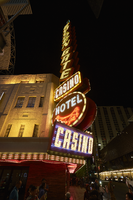
Photographs of Golden Gate Hotel and Casino signs, Las Vegas (Nev.), April 18, 2017
Date
2017-04-18
2017-09-22
Archival Collection
Description
The Golden Gate Hotel and Casino signs sit at 1 Fremont Street in Downtown Las Vegas. Information about the sign is available in the Southern Nevada Neon Survey Sheet.
Site address: 1 Fremont St
Sign owner: Derek and Greg Stevens
Sign details: This location originally held the Hotel Nevada that opened in 1906. This location had the first phone that was installed in Las Vegas in 1907. The building dates back to 1935, but in 1990 Mark and Craig Italo restored the exterior of the building to reflect the original art deco look to the building. This property was named Sal Sagev (Las Vegas spelled backwards) before it changed to the Golden Gate in 1955. This location was made famous with their bargain shrimp cocktail. This location has exhibits near their check-in desk showcasing older casino memorabilia, old slot machines, as well as an old phone.
Sign condition: 5- still shines brightly and paint is holding up very well
Sign form: Blade and semi-decorated shed
Sign-specific description: Their blade sign is on the corner of Main and Fremont on the top of the blade is a spherical yellow light with two neon 3-D diagonal oval shapes beneath it the with the top one blue and the bottom one a fuchsia pink. The main portion of the blade is made up by sideways rusty colored squares spelling out "GOLDEN GATE" in block letters (one letter in each box) each containing flashing incandescent light bulbs. Beneath this is a rusty colored rectangular box that spells out "CASINO" in the interior with white neon letters with the box outlined in sparkling incandescent light bulbs. Underneath the rectangle is a rusty colored circle with white block letters spelling out "HOTEL" in neon, and underneath the words is a red skeletal neon outline of the Golden Gate Bridge. On the corner of the building right underneath the blade is is a rectangle sign with red neon spelling out "CASINO". There are chasing incandescent light bulbs surrounding the first second story of the building with the words "GOLDEN GATE" in channeled white neon letters that are outlined with blue neon and have sparkling incandescent light bulbs at night, and are both on the west and north side of the building. Also there are the words "RESTAURANT" as well as "CASINO" both in flashing incandescent light bulbs on both sides of the building as well. There are also LED lights that illuminate the building's windows at night time.
Sign - type of display: Neon, Incandescent light bulbs and LED
Sign - media: Steel
Sign - non-neon treatments: Incandescent light bulbs on signs and LED lights illuminating the building
Sign animation: Chasing, flashing
Notes: incandescent light bulbs
Sign environment: This location is on the corner of Main and Fremont which is the entrance to the Fremont Street Experience. There is also a concert stage in front of this property. Across the street would have been the Las Vegas Club, the Glitter Gulch and Mermaids; but have been demolished in recent times.
Sign - date of installation: 1964
Sign - date of redesign/move: When the sign was installed in 1964 the bottom circle of the blade stated "HOTEL SAL SAGEV" but now there is the Golden Gate bridge, so it must have switched when the Sal Sagev name was not affiliated with that location anymore.
Sign - artistic significance: This blade looks similar to the old Sal Sagev sign that was up on this building previous to this sign. The blade also was a prominent theme for signs in the 50's and 60's especially down on Fremont.
Survey - research locations: Assessor's Page, Tour outline, Golden Gate website for history http://www.goldengatecasino.com/history/#
Survey - research notes: http://www.goldengatecasino.com/history/# has a good timeline of the history of the casino as well as some good Vegas history notes as well.
Surveyor: Emily Fellmer
Survey - date completed: 2017-09-22
Sign keywords: Neon; Incandescent; Chasing; Flashing; Decorated shed; Steel; Pole sign
Site address: 1 Fremont St
Sign owner: Derek and Greg Stevens
Sign details: This location originally held the Hotel Nevada that opened in 1906. This location had the first phone that was installed in Las Vegas in 1907. The building dates back to 1935, but in 1990 Mark and Craig Italo restored the exterior of the building to reflect the original art deco look to the building. This property was named Sal Sagev (Las Vegas spelled backwards) before it changed to the Golden Gate in 1955. This location was made famous with their bargain shrimp cocktail. This location has exhibits near their check-in desk showcasing older casino memorabilia, old slot machines, as well as an old phone.
Sign condition: 5- still shines brightly and paint is holding up very well
Sign form: Blade and semi-decorated shed
Sign-specific description: Their blade sign is on the corner of Main and Fremont on the top of the blade is a spherical yellow light with two neon 3-D diagonal oval shapes beneath it the with the top one blue and the bottom one a fuchsia pink. The main portion of the blade is made up by sideways rusty colored squares spelling out "GOLDEN GATE" in block letters (one letter in each box) each containing flashing incandescent light bulbs. Beneath this is a rusty colored rectangular box that spells out "CASINO" in the interior with white neon letters with the box outlined in sparkling incandescent light bulbs. Underneath the rectangle is a rusty colored circle with white block letters spelling out "HOTEL" in neon, and underneath the words is a red skeletal neon outline of the Golden Gate Bridge. On the corner of the building right underneath the blade is is a rectangle sign with red neon spelling out "CASINO". There are chasing incandescent light bulbs surrounding the first second story of the building with the words "GOLDEN GATE" in channeled white neon letters that are outlined with blue neon and have sparkling incandescent light bulbs at night, and are both on the west and north side of the building. Also there are the words "RESTAURANT" as well as "CASINO" both in flashing incandescent light bulbs on both sides of the building as well. There are also LED lights that illuminate the building's windows at night time.
Sign - type of display: Neon, Incandescent light bulbs and LED
Sign - media: Steel
Sign - non-neon treatments: Incandescent light bulbs on signs and LED lights illuminating the building
Sign animation: Chasing, flashing
Notes: incandescent light bulbs
Sign environment: This location is on the corner of Main and Fremont which is the entrance to the Fremont Street Experience. There is also a concert stage in front of this property. Across the street would have been the Las Vegas Club, the Glitter Gulch and Mermaids; but have been demolished in recent times.
Sign - date of installation: 1964
Sign - date of redesign/move: When the sign was installed in 1964 the bottom circle of the blade stated "HOTEL SAL SAGEV" but now there is the Golden Gate bridge, so it must have switched when the Sal Sagev name was not affiliated with that location anymore.
Sign - artistic significance: This blade looks similar to the old Sal Sagev sign that was up on this building previous to this sign. The blade also was a prominent theme for signs in the 50's and 60's especially down on Fremont.
Survey - research locations: Assessor's Page, Tour outline, Golden Gate website for history http://www.goldengatecasino.com/history/#
Survey - research notes: http://www.goldengatecasino.com/history/# has a good timeline of the history of the casino as well as some good Vegas history notes as well.
Surveyor: Emily Fellmer
Survey - date completed: 2017-09-22
Sign keywords: Neon; Incandescent; Chasing; Flashing; Decorated shed; Steel; Pole sign
Mixed Content
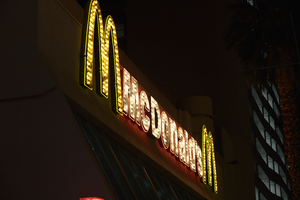
Photographs of The D signs, Las Vegas (Nev.), April 18, 2017
Date
2017-04-18
2017-08-12
Archival Collection
Description
The D Hotel and Casino sign sits at 301 Fremont Street inside the Fremont Street Experience. Photos show signs on The D, including signs for the casino itself and a McDonald's inside of it. Information about the sign is available in the Southern Nevada Neon Survey Sheet.
Site address: 301 Fremont St
Sign owner: Derek Stevens
Sign details: This location first opened as the Sundance in 1980 which was known for its affiliation with Moe Dalitz of the Cleveland syndicate. Then the location was reopened in 1987 as the Fitzgerald's by owner Don Barden, one of the first African American casino owners in Las Vegas. Then in 2012 the renovation process began for Derek Stevens to open up the D casino. The D is named after Derek Steven's hometown of Detroit, Michigan.
Sign condition: 5- Very good condition
Sign form: Variation of a Bull Nose sign, signs on buildings and other entrance signs
Sign-specific description: Above their main entrance on Third and Fremont there is a black backdrop that states "the D" the letters the are in gold lights, then the letter D is in a big red steel box that showcases a tv screen in the big part of the letter, but this letter is outlined in two strips of red neon. Underneath this variation of a bull nose sign is a tv plasma screen that they have wrapped around the building. - On the second story of their casino there is a Vintage Vegas section that can be accessed from the street via escalator, above this second floor entrance is a sign stating "the D Vintage Vegas" At the Top of the building is an animated sculptural sign which is a slot machine with a lever that pulls down with the reels changing such as an old slot machine would have done. Then below this are neon coins that light up in order to look like they are falling out of the slot machine. On the top left portion of the coins states "the (in white) D (in red)", but under the logo is a solid yellow neon line. On top of the yellow line states "Vintage" and on the bottom states "Vegas" in a retro 50's 60's font.
Sign - type of display: Neon, LED, Plasma screen
Sign - media: Steel, some plastic
Sign - non-neon treatments: Light bulbs, T.V. screen and sculptural sign
Sign animation: The coins light up in order to look as though they are falling out of the sculptural slot machine. The lever on the slot machine moves to activate the moving reels in the slot machine.
Sign environment: On the corner of Third and Fremont St. West of the building is the Four Queens, to the North West is the Fremont Casino and Hotel. Across Fremont street from the D is little shops including where the El Portal Movie Theater used to be. Also along Fremont Street the D opened a bar which is very helpful with foot traffic. Also Third Street right in front of their main entrance there is a stage that hold concerts.
Sign manufacturer: AD/S Companies
Sign - date of installation: 2012
Sign - thematic influences: This variation of a Bull Nose sign is similar to many of the other entrance signs for casinos on Fremont Street.
Sign - artistic significance: The Vintage Vegas sign has a retro 1950's/60's type font. The sign really does represent the theme of that section of the casino well by having the old slot machine sculptural sign.
Survey - research locations: Acessor's office website, the D website http://www.thed.com/hotel/ , Neon Museum Tour Manual
Survey - research notes: Derek Stevens also owns the Golden Gate. He bought out the Glitter Gulch, Mermaids and La Bayou in 2015 then the Las Vegas club in 2016. La Bayou was demolished in 2016. The summer of 2017 is when the demolition of Glitter Gulch, Mermaids and the Las Vegas Club began.
Surveyor: Emily Fellmer
Survey - date completed: 2017-08-12
Sign keywords: Neon; LED; Steel; Plastic; Bullnose; Building-front design; Plasma display; Video screen; Sculptural
Site address: 301 Fremont St
Sign owner: Derek Stevens
Sign details: This location first opened as the Sundance in 1980 which was known for its affiliation with Moe Dalitz of the Cleveland syndicate. Then the location was reopened in 1987 as the Fitzgerald's by owner Don Barden, one of the first African American casino owners in Las Vegas. Then in 2012 the renovation process began for Derek Stevens to open up the D casino. The D is named after Derek Steven's hometown of Detroit, Michigan.
Sign condition: 5- Very good condition
Sign form: Variation of a Bull Nose sign, signs on buildings and other entrance signs
Sign-specific description: Above their main entrance on Third and Fremont there is a black backdrop that states "the D" the letters the are in gold lights, then the letter D is in a big red steel box that showcases a tv screen in the big part of the letter, but this letter is outlined in two strips of red neon. Underneath this variation of a bull nose sign is a tv plasma screen that they have wrapped around the building. - On the second story of their casino there is a Vintage Vegas section that can be accessed from the street via escalator, above this second floor entrance is a sign stating "the D Vintage Vegas" At the Top of the building is an animated sculptural sign which is a slot machine with a lever that pulls down with the reels changing such as an old slot machine would have done. Then below this are neon coins that light up in order to look like they are falling out of the slot machine. On the top left portion of the coins states "the (in white) D (in red)", but under the logo is a solid yellow neon line. On top of the yellow line states "Vintage" and on the bottom states "Vegas" in a retro 50's 60's font.
Sign - type of display: Neon, LED, Plasma screen
Sign - media: Steel, some plastic
Sign - non-neon treatments: Light bulbs, T.V. screen and sculptural sign
Sign animation: The coins light up in order to look as though they are falling out of the sculptural slot machine. The lever on the slot machine moves to activate the moving reels in the slot machine.
Sign environment: On the corner of Third and Fremont St. West of the building is the Four Queens, to the North West is the Fremont Casino and Hotel. Across Fremont street from the D is little shops including where the El Portal Movie Theater used to be. Also along Fremont Street the D opened a bar which is very helpful with foot traffic. Also Third Street right in front of their main entrance there is a stage that hold concerts.
Sign manufacturer: AD/S Companies
Sign - date of installation: 2012
Sign - thematic influences: This variation of a Bull Nose sign is similar to many of the other entrance signs for casinos on Fremont Street.
Sign - artistic significance: The Vintage Vegas sign has a retro 1950's/60's type font. The sign really does represent the theme of that section of the casino well by having the old slot machine sculptural sign.
Survey - research locations: Acessor's office website, the D website http://www.thed.com/hotel/ , Neon Museum Tour Manual
Survey - research notes: Derek Stevens also owns the Golden Gate. He bought out the Glitter Gulch, Mermaids and La Bayou in 2015 then the Las Vegas club in 2016. La Bayou was demolished in 2016. The summer of 2017 is when the demolition of Glitter Gulch, Mermaids and the Las Vegas Club began.
Surveyor: Emily Fellmer
Survey - date completed: 2017-08-12
Sign keywords: Neon; LED; Steel; Plastic; Bullnose; Building-front design; Plasma display; Video screen; Sculptural
Mixed Content
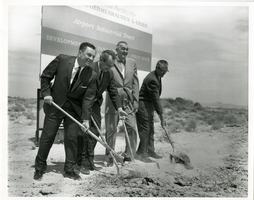
Photograph of Mayor Oran K. Gragson attending the groundbreaking for a new research facility for EG&G, May, 1963
Date
1963-05
Archival Collection
Description
Las Vegas Mayor Oran K. Gragson attending the groundbreaking for a new research facility for Edgerton, Germeshausen & Grier (EG&G), May 1963. Pictured L-R: U. S. Nevada Senator Howard Cannon, U. S. Nevada Senator Alan Bible, Herbert E. Grier (?), and Las Vegas Mayor Oran Gragson (far right). The sign behind them reads "New Research Facility for Edgerton, Gereshausen & Grier Airport Industrial Tract Development of E. Parry Thomas-Jerry Mack and Haas-Haynie Corp." Oran Kenneth Gragson (February 14, 1911 – October 7, 2002) was an American businessman and politician. He was the longest-serving mayor of Las Vegas, Nevada, from 1959 to 1975. Gragson, a member of the Republican Party, was a small business owner who was elected Mayor on a reform platform against police corruption and for equal opportunity for people of all socio-economic and racial categories. Gragson died in a Las Vegas hospice on October 7, 2002, at the age of 91. The Oran K. Gragson Elementary School located at 555 N. Honolulu Street, Las Vegas, NV 89110 was named in his honor. Howard Walter Cannon (January 26, 1912 – March 5, 2002) was an American politician. He served as a United States Senator from Nevada from 1959 until 1983 as a member of the Democratic Party. In 1956, Cannon ran for the United States House of Representatives to succeed Republican incumbent Clarence Clifton Young, who ran for the U.S. Senate, but lost the Democratic primary to former Congressman Walter Baring, who then won the general election. In 1958, he was elected to the United States Senate, unseating Republican Senator George W. Malone with 58% of the vote.. Cannon was nearly defeated in his first re-election bid in 1964, holding off Republican Lieutenant Governor Paul Laxalt in one of the closest Senate elections ever. Alan Harvey Bible (November 20, 1909 – September 12, 1988) was an American lawyer and politician. A member of the Democratic Party, he served as a United States Senator from Nevada from 1954 to 1974. He previously served as Attorney General of Nevada from 1942 to 1950. In 1952, Bible was narrowly defeated for the Democratic nomination for the United States Senate, losing to political newcomer Thomas B. Mechling by 475 votes. However, after the death of Senator McCarran in September 1954, Bible was elected to the Senate the following November to fill the remainder of McCarran's term. He defeated Republican Ernest S. Brown, who had been appointed to McCarran's seat by Governor Charles H. Russell, by a margin of 58%-42%. He was reelected in 1956, 1962, and again in 1968 and represented Nevada in the United States Senate from December 2, 1954, until his resignation on December 17, 1974. During his time in the United States Senate, he was chairman of the Committee on the District of Columbia (Eighty-fifth through Ninetieth Congresses), the Joint Committee on Washington Metropolitan Problems (Eighty-fifth and Eighty-sixth Congresses), and the U.S. Senate Select Committee on Small Business (Ninety-first through Ninety-third Congresses). He is buried in Reno, Nevada.
Image
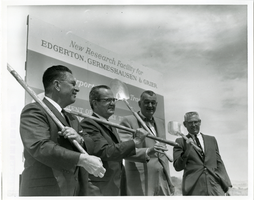
Photograph of Mayor Oran K. Gragson attending the groundbreaking for a new research facility for EG&G, May, 1963
Date
1963-05
Archival Collection
Description
Las Vegas Mayor Oran K. Gragson attending the groundbreaking for a new research facility for Edgerton, Germeshausen & Grier (EG&G), May 1963. Pictured L-R: U. S. Nevada Senator Howard Cannon, U. S. Nevada Senator Alan Bible, Herbert E. Grier (?), and Las Vegas Mayor Oran K. Gragson. The sign behind them reads "New Research Facility for Edgerton, Gereshausen & Grier Airport Industrial Tract Development of E. Parry Thomas-Jerry Mack and Haas-Haynie Corp." Oran Kenneth Gragson (February 14, 1911 – October 7, 2002) was an American businessman and politician. He was the longest-serving mayor of Las Vegas, Nevada, from 1959 to 1975. Gragson, a member of the Republican Party, was a small business owner who was elected Mayor on a reform platform against police corruption and for equal opportunity for people of all socio-economic and racial categories. Gragson died in a Las Vegas hospice on October 7, 2002, at the age of 91. The Oran K. Gragson Elementary School located at 555 N. Honolulu Street, Las Vegas, NV 89110 was named in his honor. Howard Walter Cannon (January 26, 1912 – March 5, 2002) was an American politician. He served as a United States Senator from Nevada from 1959 until 1983 as a member of the Democratic Party. In 1956, Cannon ran for the United States House of Representatives to succeed Republican incumbent Clarence Clifton Young, who ran for the U.S. Senate, but lost the Democratic primary to former Congressman Walter Baring, who then won the general election. In 1958, he was elected to the United States Senate, unseating Republican Senator George W. Malone with 58% of the vote.. Cannon was nearly defeated in his first re-election bid in 1964, holding off Republican Lieutenant Governor Paul Laxalt in one of the closest Senate elections ever. Alan Harvey Bible (November 20, 1909 – September 12, 1988) was an American lawyer and politician. A member of the Democratic Party, he served as a United States Senator from Nevada from 1954 to 1974. He previously served as Attorney General of Nevada from 1942 to 1950. In 1952, Bible was narrowly defeated for the Democratic nomination for the United States Senate, losing to political newcomer Thomas B. Mechling by 475 votes. However, after the death of Senator McCarran in September 1954, Bible was elected to the Senate the following November to fill the remainder of McCarran's term. He defeated Republican Ernest S. Brown, who had been appointed to McCarran's seat by Governor Charles H. Russell, by a margin of 58%-42%. He was reelected in 1956, 1962, and again in 1968 and represented Nevada in the United States Senate from December 2, 1954, until his resignation on December 17, 1974. During his time in the United States Senate, he was chairman of the Committee on the District of Columbia (Eighty-fifth through Ninetieth Congresses), the Joint Committee on Washington Metropolitan Problems (Eighty-fifth and Eighty-sixth Congresses), and the U.S. Senate Select Committee on Small Business (Ninety-first through Ninety-third Congresses). He is buried in Reno, Nevada.
Image
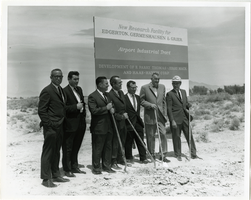
Photograph of Mayor Oran K. Gragson attending the groundbreaking for a new research facility for EG&G, May, 1963
Date
1963-05
Archival Collection
Description
Mayor Oran K. Gragson attending the groundbreaking for a new research facility for Edgerton, Germeshausen & Grier (EG&G), May 1963. Pictured are U. S. Nevada Senator Howard Cannon (3rd from left), U. S. Nevada Senator Alan Bible (4th from left), and Las Vegas Mayor Oran K. Gragson (far right). The sign behind them reads "New Research Facility for Edgerton, Gereshausen & Grier Airport Industrial Tract Development of E. Parry Thomas-Jerry Mack and Haas-Haynie Corp." Oran Kenneth Gragson (February 14, 1911 – October 7, 2002) was an American businessman and politician. He was the longest-serving mayor of Las Vegas, Nevada, from 1959 to 1975. Gragson, a member of the Republican Party, was a small business owner who was elected Mayor on a reform platform against police corruption and for equal opportunity for people of all socio-economic and racial categories. Gragson died in a Las Vegas hospice on October 7, 2002, at the age of 91. The Oran K. Gragson Elementary School located at 555 N. Honolulu Street, Las Vegas, NV 89110 was named in his honor. Howard Walter Cannon (January 26, 1912 – March 5, 2002) was an American politician. He served as a United States Senator from Nevada from 1959 until 1983 as a member of the Democratic Party. In 1956, Cannon ran for the United States House of Representatives to succeed Republican incumbent Clarence Clifton Young, who ran for the U.S. Senate, but lost the Democratic primary to former Congressman Walter Baring, who then won the general election. In 1958, he was elected to the United States Senate, unseating Republican Senator George W. Malone with 58% of the vote.. Cannon was nearly defeated in his first re-election bid in 1964, holding off Republican Lieutenant Governor Paul Laxalt in one of the closest Senate elections ever. Alan Harvey Bible (November 20, 1909 – September 12, 1988) was an American lawyer and politician. A member of the Democratic Party, he served as a United States Senator from Nevada from 1954 to 1974. He previously served as Attorney General of Nevada from 1942 to 1950. In 1952, Bible was narrowly defeated for the Democratic nomination for the United States Senate, losing to political newcomer Thomas B. Mechling by 475 votes. However, after the death of Senator McCarran in September 1954, Bible was elected to the Senate the following November to fill the remainder of McCarran's term. He defeated Republican Ernest S. Brown, who had been appointed to McCarran's seat by Governor Charles H. Russell, by a margin of 58%-42%. He was reelected in 1956, 1962, and again in 1968 and represented Nevada in the United States Senate from December 2, 1954, until his resignation on December 17, 1974. During his time in the United States Senate, he was chairman of the Committee on the District of Columbia (Eighty-fifth through Ninetieth Congresses), the Joint Committee on Washington Metropolitan Problems (Eighty-fifth and Eighty-sixth Congresses), and the U.S. Senate Select Committee on Small Business (Ninety-first through Ninety-third Congresses). He is buried in Reno, Nevada.
Image
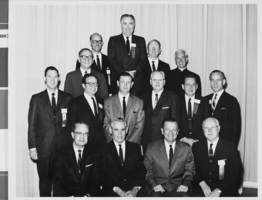
Photograph of Mayor Oran K. Gragson and other attendees of the International Exposition of Flight and General Aviation Conference, circa 1960s
Date
1960 to 1969
Archival Collection
Description
Attendees of the International Exposition of Flight and General Aviation Conference. Pictured are: Front row, L-R: U. S. Nevada Senator Alan Bible, Las Vegas Mayor Oran K. Gragson, U. S. Nevada Senator Howard Cannon. Some of the men have a ribbon attached to their badge that reads "IEF." The location where the photograph was taken is unknown. Oran Kenneth Gragson (February 14, 1911 – October 7, 2002) was an American businessman and politician. He was the longest-serving mayor of Las Vegas, Nevada, from 1959 to 1975. Gragson, a member of the Republican Party, was a small business owner who was elected Mayor on a reform platform against police corruption and for equal opportunity for people of all socio-economic and racial categories. Gragson died in a Las Vegas hospice on October 7, 2002, at the age of 91. The Oran K. Gragson Elementary School located at 555 N. Honolulu Street, Las Vegas, NV 89110 was named in his honor. Howard Walter Cannon (January 26, 1912 – March 5, 2002) was an American politician. He served as a United States Senator from Nevada from 1959 until 1983 as a member of the Democratic Party. In 1956, Cannon ran for the United States House of Representatives to succeed Republican incumbent Clarence Clifton Young, who ran for the U.S. Senate, but lost the Democratic primary to former Congressman Walter Baring, who then won the general election. In 1958, he was elected to the United States Senate, unseating Republican Senator George W. Malone with 58% of the vote.. Cannon was nearly defeated in his first re-election bid in 1964, holding off Republican Lieutenant Governor Paul Laxalt in one of the closest Senate elections ever. Alan Harvey Bible (November 20, 1909 – September 12, 1988) was an American lawyer and politician. A member of the Democratic Party, he served as a United States Senator from Nevada from 1954 to 1974. He previously served as Attorney General of Nevada from 1942 to 1950. In 1952, Bible was narrowly defeated for the Democratic nomination for the United States Senate, losing to political newcomer Thomas B. Mechling by 475 votes. However, after the death of Senator McCarran in September 1954, Bible was elected to the Senate the following November to fill the remainder of McCarran's term. He defeated Republican Ernest S. Brown, who had been appointed to McCarran's seat by Governor Charles H. Russell, by a margin of 58%-42%. He was reelected in 1956, 1962, and again in 1968 and represented Nevada in the United States Senate from December 2, 1954, until his resignation on December 17, 1974. During his time in the United States Senate, he was chairman of the Committee on the District of Columbia (Eighty-fifth through Ninetieth Congresses), the Joint Committee on Washington Metropolitan Problems (Eighty-fifth and Eighty-sixth Congresses), and the U.S. Senate Select Committee on Small Business (Ninety-first through Ninety-third Congresses). He is buried in Reno, Nevada.
Image
Pagination
Refine my results
Content Type
Creator or Contributor
Subject
Archival Collection
Digital Project
Resource Type
Year
Material Type
Place
Language
Records Classification

